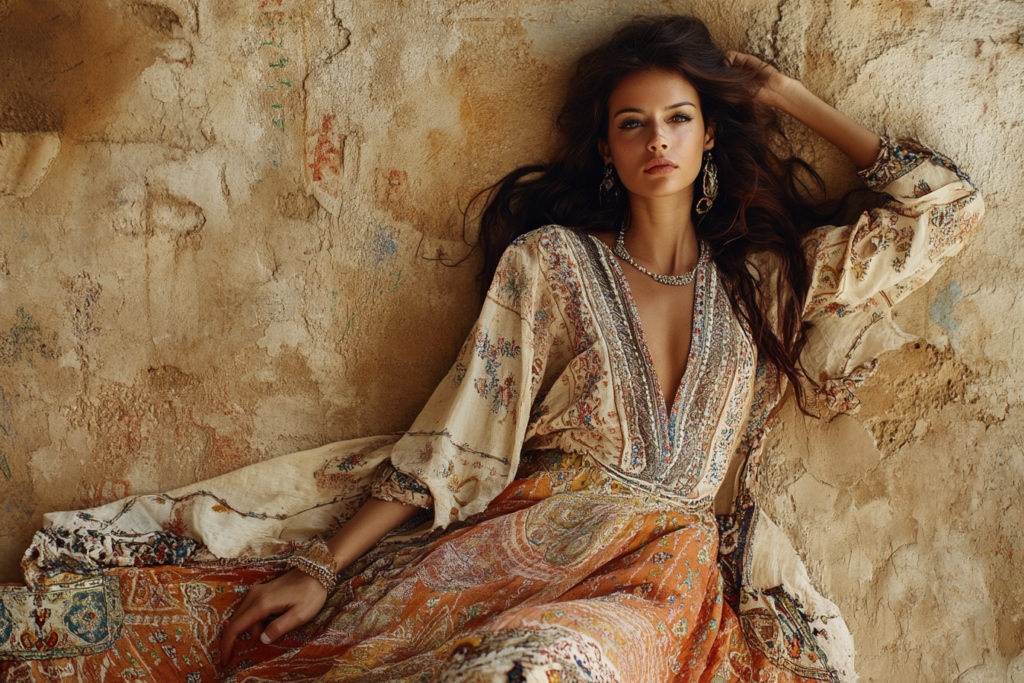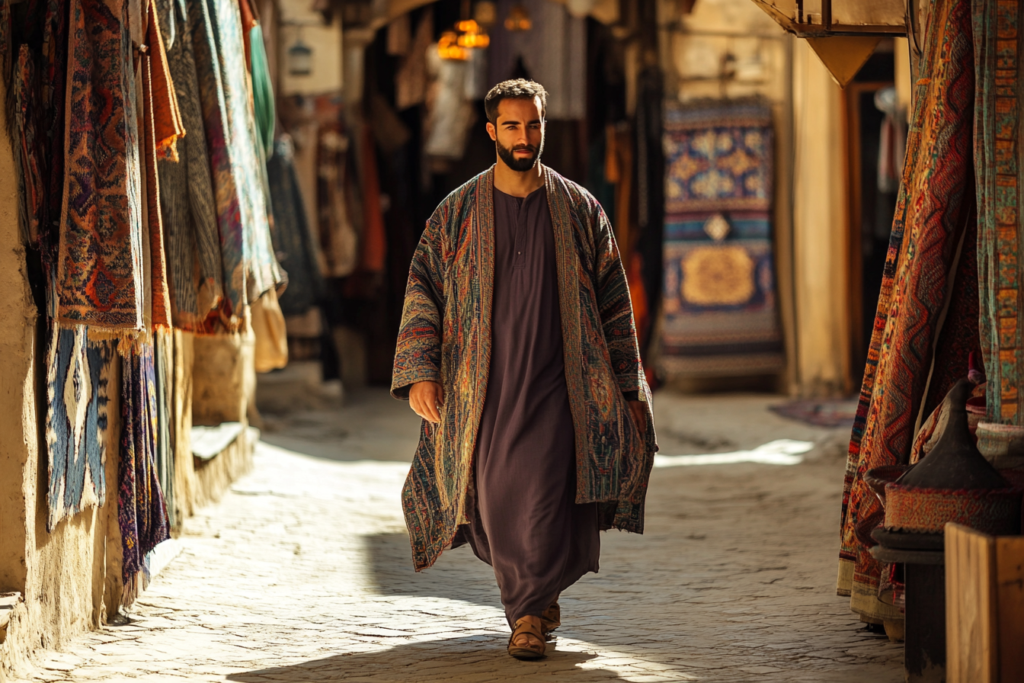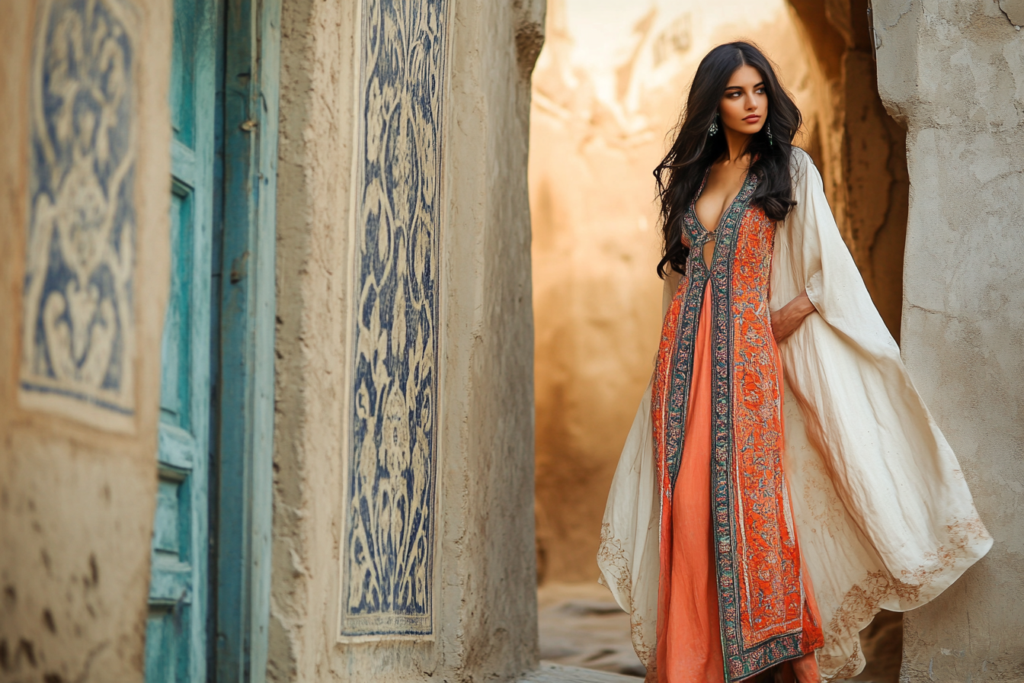Introduction: What is a Kaftan?
A Kaftan is a traditional garment with a rich cultural history, known for its elegant and free-flowing design. This long-sleeved or half-sleeved ankle-length coat and skirt combination offers a relaxed, comfortable fit, making it a timeless piece in many wardrobes around the world. The Kaftan has been cherished for centuries in various regions, particularly in the Middle East, North Africa, and Central Asia, and its versatility has made it a staple in both casual and formal fashion.
The Kaftan is often made from luxurious fabrics such as silk, velvet, or cotton, and is characterized by its loose, flowing lines that offer both style and comfort. In this article, we’ll delve into the history, design features, and the versatility of the Kaftan, as well as how to wear it in contemporary fashion.


The History and Origins of the Kaftan
The Kaftan has a long history dating back to ancient civilizations, particularly in the Middle East and Central Asia. It was initially worn by royalty, aristocrats, and the elite as a symbol of status and wealth. The Kaftan‘s design, with its loose fit and flowing lines, was ideal for the warm climates of these regions, allowing for both comfort and elegance.
Over time, the Kaftan spread across different parts of the world, from North Africa to Europe, and was adapted to suit various cultural and regional preferences. Today, the Kaftan is a globally recognized garment, worn for both casual occasions and formal events.
Design Features of the Traditional Kaftan
The traditional Kaftan is defined by its flowing silhouette, which allows for freedom of movement. Here are the key design features that make the Kaftan distinctive:
- Length:
- The Kaftan typically reaches ankle-length, offering a modest and elegant appearance. Some modern variations may be shorter, but the ankle-length design remains the most traditional.
- Sleeves:
- Kaftans usually have long or half-sleeves, making them versatile for both cooler and warmer weather. The loose sleeves add to the overall flowing aesthetic of the garment.
- Loose Fit:
- One of the most notable characteristics of the Kaftan is its loose, flowing fit. This design allows for comfort and ease of movement, making it a favorite choice for hot climates where ventilation is key.
- Open Front:
- The Kaftan often features an open front, which can be left unfastened for a relaxed look or closed with a belt or sash for a more structured style.
- Luxurious Fabrics:
- Traditional Kaftans are often made from luxurious fabrics such as silk, cotton, and velvet, which add to the garment’s elegance and opulence. Modern variations may use lighter fabrics for casual wear, such as cotton or linen.
- Embroidery and Embellishments:
- Many Kaftans are adorned with intricate embroidery, beading, or embellishments that add to their beauty and sophistication. These details often reflect the cultural heritage of the region in which the Kaftan was made.
Cultural Significance of the Kaftan
The Kaftan has significant cultural meaning in various regions of the world. Here are a few key aspects of its cultural importance:
- Symbol of Royalty:
- Historically, the Kaftan was worn by kings, queens, and aristocrats as a symbol of wealth, power, and luxury. Its ornate designs, expensive fabrics, and craftsmanship were reserved for the elite.
- Traditional Ceremonial Garment:
- In many cultures, the Kaftan is worn during special occasions and ceremonies, such as weddings, religious holidays, and festivals. It continues to be a garment of choice for important events in countries like Morocco, Turkey, and Iran.
- Modesty and Comfort:
- The Kaftan‘s loose, flowing design makes it a modest garment that offers comfort without sacrificing style. This has made it a favored choice for women seeking elegant, modest clothing.
- Cultural Identity:
- For many regions, the Kaftan is a strong symbol of cultural identity. It reflects the region’s craftsmanship, textiles, and design preferences. The Kaftan has evolved over time but remains a garment that ties people to their cultural heritage.
Modern Interpretations of the Kaftan
In contemporary fashion, the Kaftan has undergone several transformations while still retaining its traditional features. Today, you can find the Kaftan in various forms, from casual beachwear to evening gowns. Modern designers have reimagined the Kaftan to suit various styles and occasions, making it a versatile garment for every wardrobe.
- Casual Wear:
- In modern fashion, Kaftans are often made from lighter materials like cotton or linen, making them perfect for casual outings or beach vacations. These more relaxed versions of the Kaftan are often worn over swimsuits or paired with sandals for an effortless yet stylish look.
- Evening Wear:
- For formal events, Kaftans are made from luxurious fabrics such as silk or satin and often feature intricate embroidery, beads, or sequins. These elegant designs are perfect for evening wear, offering a sophisticated and timeless look for events like weddings or galas.
- Versatile Styles:
- Modern Kaftans come in a wide variety of cuts and styles, from traditional long versions to shorter, more tailored ones. Many feature modern prints, bold colors, and contemporary patterns, making them adaptable for different fashion tastes.
How to Wear a Kaftan
The Kaftan is incredibly versatile and can be styled in a variety of ways to suit different occasions. Here are a few tips on how to wear a Kaftan:
- For a Casual Look:
- Pair a lightweight Kaftan with sandals or flip-flops for a laid-back, beach-ready look. A simple, flowing Kaftan with a light print can be perfect for a day at the beach or a casual gathering.
- For Formal Occasions:
- Opt for a Kaftan made from rich fabrics like silk, satin, or velvet for a more elegant appearance. Pair it with statement jewelry, heels, and a clutch for a chic and sophisticated evening look.
- Layering with Accessories:
- The Kaftan can be worn with a wide range of accessories to enhance the overall look. Add a wide belt to cinch the waist and create more structure, or layer with a stylish scarf or shawl for extra warmth or style.
- As a Cover-Up:
- A Kaftan is perfect as a cover-up for swimwear, offering both style and comfort by the poolside or at the beach. Its loose fit provides coverage while keeping you cool and relaxed.
Conclusion: The Enduring Elegance of the Kaftan
The Kaftan is a garment that has stood the test of time, blending comfort, elegance, and cultural significance into one versatile piece of clothing. Whether worn as a casual outfit for the beach or a luxurious evening gown for formal events, the Kaftan continues to be a beloved garment worldwide. Its free-flowing design and timeless appeal make it a staple for any wardrobe, offering an effortlessly chic look for women of all ages.



